Lesson 7
Using Diagrams to Represent Multiplication
7.1: Estimate the Product (5 minutes)
Warm-up
This warm-up prompts students to review multiplication of decimals and think about the size of a product given the decimals being multiplied. In grade 5, students multiplied decimals to hundredths using concrete representations or drawings, place-value strategies, and properties of operations. Though they may know how to find decimal products up to hundredths, they may not always consider the reasonableness of their answers. Students may simply perform the computation and “count the number of decimal places” to put the decimal point in the product. Discuss why each estimated product makes sense based on what they know about place value and multiplication.
Launch
Tell students you will display a multiplication expression along with three possible estimates of its value. Their job is to select the best estimate and be able to explain why it is the best. Display one problem at a time. Give students 30 seconds of quiet think time per problem and ask them to give a signal when they have an answer and a strategy. Follow with a whole-class discussion.
Student Facing
For each of the following products, choose the best estimate of its value. Be prepared to explain your reasoning.
-
\((6.8) \boldcdot (2.3)\)
- 1.40
- 14
- 140
-
\(74 \boldcdot (8.1)\)
- 5.6
- 56
- 560
-
\(166 \boldcdot (0.09)\)
- 1.66
- 16.6
- 166
-
\((3.4) \boldcdot (1.9)\)
- 6.5
- 65
- 650
Student Response
For access, consult one of our IM Certified Partners.
Anticipated Misconceptions
Some students might mix together an estimation strategy (e.g., rounding the factors) and the method of “counting the number of decimal places” (which is applied to precise calculations) and put the decimal point in their estimate. For example, to estimate \(74 \boldcdot (8.1)\), they might round the factors to 70 and 8 and find a product of 560. But because they see that there is a total of 1 place after the decimal point in the original factors, they move the decimal point in 560 one place to the left and choose 56 as their answer. Prompt students to think about the reasonableness of their answer relative to the factors (e.g., ask if 56 is a reasonable product of 70 and 8).
Activity Synthesis
Discuss one problem at a time. Ask students to share their response and reasoning. Record and display student explanations for all to see. If not mentioned by students in their explanations, ask if or how the given factors impacted how they estimated. To involve more students in the conversation, consider asking:
- “Who can restate ___’s reasoning in a different way?”
- “Does anyone want to add on to _____’s strategy?”
- “Do you agree or disagree? Why?” If there is time, ask students to solve the final problem with a partner. Encourage them to solve it mentally first and then check with pencil and paper if necessary.
7.2: Connecting Area Diagrams to Calculations with Whole Numbers (20 minutes)
Optional activity
In this activity, students review two numerical methods for multiplication learned in previous grades and use them to calculate products of whole numbers. Students have had a chance to revisit area diagrams in the past couple of activities. Here they make explicit connections between numerical calculations and area diagrams. As in previous activities, place value plays a key role in how a rectangle can be partitioned to facilitate multiplication.
As students discuss and work, notice the ways they describe the correspondences between numerical calculations and the numbers in the area diagrams. Identify students who can clearly articulate their reasoning so they can share later.
Launch
Arrange students in groups of 2. Give groups 3–5 minutes to discuss and answer the first set of questions. Follow with a brief whole-class discussion. Select a few students to share their responses to the first set of questions. Ask students why factors are decomposed by place value (e.g., 20 and 4), as opposed to decomposing into any two numbers (e.g., 13 and 11)? (It is easier to multiply two numbers if there is only 1 non-zero digit in each.)
Give groups another 3–5 minutes to discuss and answer the second set of questions. Follow with a brief whole-class discussion. Highlight the relationship between the blue numbers in the calculations and the partial areas in the diagram. Discuss:
- The numbers in blue—in the calculations and area diagrams—are called “partial products.” Why might that be? (They represent products of parts of the factors.)
- How are the partial products in Calculation A different from those in Calculation B? (Calculation A lists the product of any two base-ten digits separately. Calculation B groups them.) How are they similar? (They both lead to the same final product.)
Next, give students a few minutes of quiet time to complete the remaining set of questions.
Students using the digital activity should complete the written work first, and then check their work using the applet. Encourage them to explore other multiplication expressions or find other products to deepen their understanding of the area diagram.
Supports accessibility for: Visual-spatial processing
Student Facing
-
Here are three ways of finding the area of a rectangle that is 24 units by 13 units.
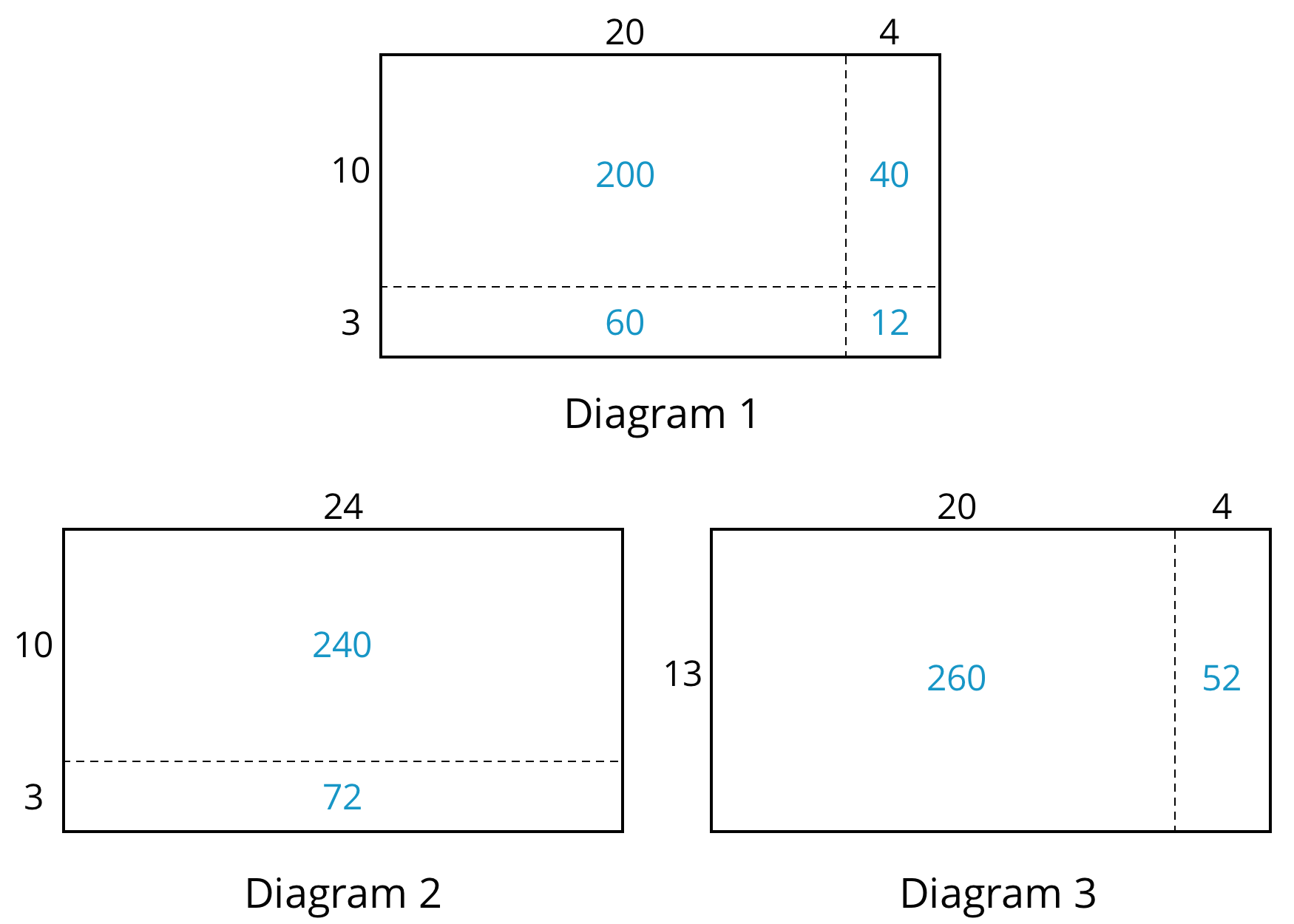
Discuss with your partner:
- What do the diagrams have in common? How are they alike?
- How are they different?
- If you were to find the area of a rectangle that is 37 units by 19 units, which of the three ways of decomposing the rectangle would you use? Why?
-
You may be familiar with different ways to write multiplication calculations. Here are two ways to calculate 24 times 13.

Discuss with your partner:
- In Calculation A, how are each of the partial products obtained? For instance, where does the 12 come from?
- In Calculation B, how are the 72 and 240 obtained?
- Look at the diagrams in the first question. Which diagram corresponds to Calculation A? Which one corresponds to Calculation B?
-
How are the partial products in Calculation A and the 72 and 240 in Calculation B related to the numbers in the diagrams?
-
Use the two following methods to find the product of 18 and 14, then compare the values obtained.
- Calculate numerically.
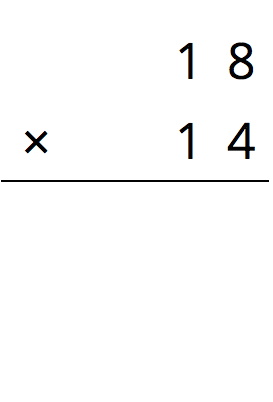
-
Here is a rectangle that is 18 units by 14 units. Find its area, in square units by decomposing it. Show your reasoning.
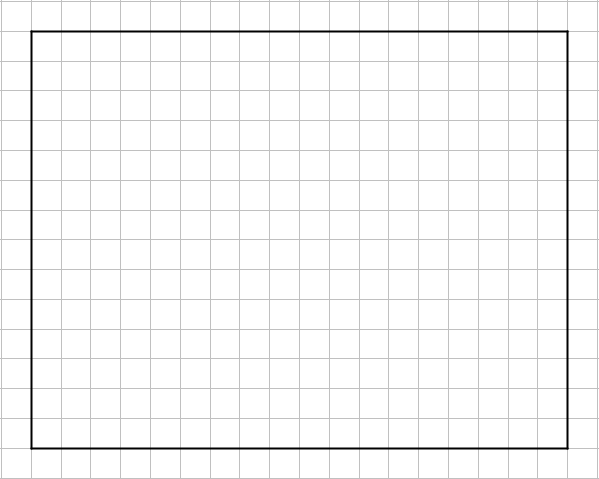
- Calculate numerically.
-
Compare the values of \(18 \boldcdot 14\) that you obtained using the two methods. If they are not the same, check your work.
-
Use the applet to verify your answers and explore your own scenarios. To adjust the values, move the dots on the ends of the segments.
Student Response
For access, consult one of our IM Certified Partners.
Launch
Arrange students in groups of 2. Give groups 3–5 minutes to discuss and answer the first set of questions. Follow with a brief whole-class discussion. Select a few students to share their responses to the first set of questions. Ask students why factors are decomposed by place value (e.g., 20 and 4), as opposed to decomposing into any two numbers (e.g., 13 and 11)? (It is easier to multiply two numbers if there is only 1 non-zero digit in each.)
Give groups another 3–5 minutes to discuss and answer the second set of questions. Follow with a brief whole-class discussion. Highlight the relationship between the blue numbers in the calculations and the partial areas in the diagram. Discuss:
- The numbers in blue—in the calculations and area diagrams—are called “partial products.” Why might that be? (They represent products of parts of the factors.)
- How are the partial products in Calculation A different from those in Calculation B? (Calculation A lists the product of any two base-ten digits separately. Calculation B groups them.) How are they similar? (They both lead to the same final product.)
Next, give students a few minutes of quiet time to complete the remaining set of questions.
Students using the digital activity should complete the written work first, and then check their work using the applet. Encourage them to explore other multiplication expressions or find other products to deepen their understanding of the area diagram.
Supports accessibility for: Visual-spatial processing
Student Facing
-
Here are three ways of finding the area of a rectangle that is 24 units by 13 units.

- What do the diagrams have in common? How are they the same?
- How are the diagrams different?
- If you were to find the area of a rectangle that is 37 units by 19 units, which of the three ways of decomposing the rectangle would you use? Why?
-
You may be familiar with different ways to write multiplication calculations. Here are two ways to calculate 24 times 13.

- In Calculation A, how are each of the partial products obtained? For instance, where does the 12 come from?
- In Calculation B, how are the 72 and 240 obtained?
- Look at the diagrams in the first question. Which diagram corresponds to Calculation A? Which one corresponds to Calculation B?
-
How are the partial products in Calculation A and the 72 and 240 in Calculation B related to the numbers in the diagrams?
-
Use the two following methods to find the product of 18 and 14.
- Calculate numerically.

-
Here is a rectangle that is 18 units by 14 units. Find its area, in square units, by decomposing it. Show your reasoning.

- Calculate numerically.
-
Compare the values of \(18 \boldcdot 14\) that you obtained using the two methods. If they are not the same, check your work.
Student Response
For access, consult one of our IM Certified Partners.
Anticipated Misconceptions
If students have trouble seeing the correspondence between the diagram and the numbers in Calculation B, consider asking them to shade the areas 60 and 12 in one color and the areas 200 and 40 in another color.
Activity Synthesis
Conclude with a whole-class discussion that focuses on connecting the numbers in Calculation B to the multiplication algorithm students learned in grade 5. Discuss:
- Calculation B shows the multiplication algorithm we can use to multiply 24 and 13 even without an area diagram. What calculation would give us the 72? What about the 240? (The two numbers in blue come from multiplying each digit of the second factor—starting from the ones place—by the first factor. The 72 is the product of 3 and 24. The 24 is the product of 10 and 24, or the 1 in the tens place and the 24.)
- There is a variation to Calculation B in which the zero in the ones place is not written (as shown), but the result is the same. Why might it be fine to write “24” without the zero at the end? (The 24 is understood to mean “24 tens” because it is written with 4 in the tens place.)
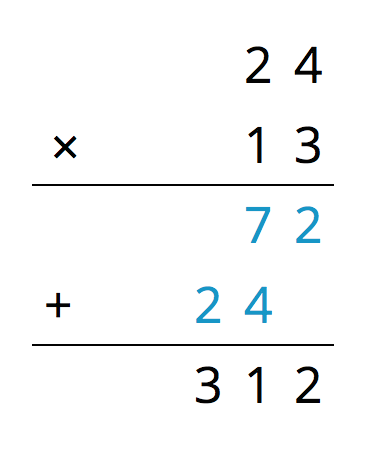
Also consider exploring other multiplication scenarios with this digital applet: https://ggbm.at/K9B6Eg4H.
7.3: Connecting Area Diagrams to Calculations with Decimals (20 minutes)
Activity
This activity extends the previous optional activity to products of decimals. It opens with a slight variant of the product \(24 \boldcdot 13\), namely \((2.4) \boldcdot (1.3)\). The side lengths of the area diagrams are multiplied by 0.1, but the reasoning involved is unchanged. While students can find the product using any of the previously developed pathways—i.e., multiplying the factors by powers of 0.1 or \(\frac{1}{10}\), or by using fractions—the focus here is on using partial products and connecting them to the multiplication algorithm. In the next lesson, students will generalize the process and use the algorithm to compute products of other decimals.
Recognition and use of structure (MP7) are once again important here. The use of the same non-zero digits in the problems also gives students a chance to see regularity in the reasoning and to focus on how the decimal point affects the calculation (MP8).
Launch
Arrange students in groups of 2. Give students 1–2 minutes of quiet think time for the first problem. Pause for a brief whole-class discussion, making sure all students label each region correctly. Explain that the diagram is not to scale, and that when drawing an area diagram, it is fine to estimate appropriate side lengths.
Have partners analyze the calculations in the second question. Monitor student discussions to check for understanding. If necessary, pause to have a whole-class discussion on the interpretation of these calculations. Then give students 7–8 minutes of quiet time to complete the remaining questions. Follow up with a whole-class discussion to emphasize how partial area products relate to the calculations.
Students with access to the digital materials can also work in groups of 2. When using the applet, students adjust the values by moving the dots on the ends of the segments to match the calculation. After giving students 3–4 minutes to log-in and complete the first problem, pause to discuss, making sure all students label each region correctly. Then they should also use the applet to check their calculations. Explain that diagrams may not be to scale, and that when drawing an area diagram, it is fine to estimate appropriate side lengths.
Supports accessibility for: Visual-spatial processing
Student Facing
- You can use area diagrams to represent products of decimals. Here is an area diagram that represents \((2.4) \boldcdot (1.3)\).
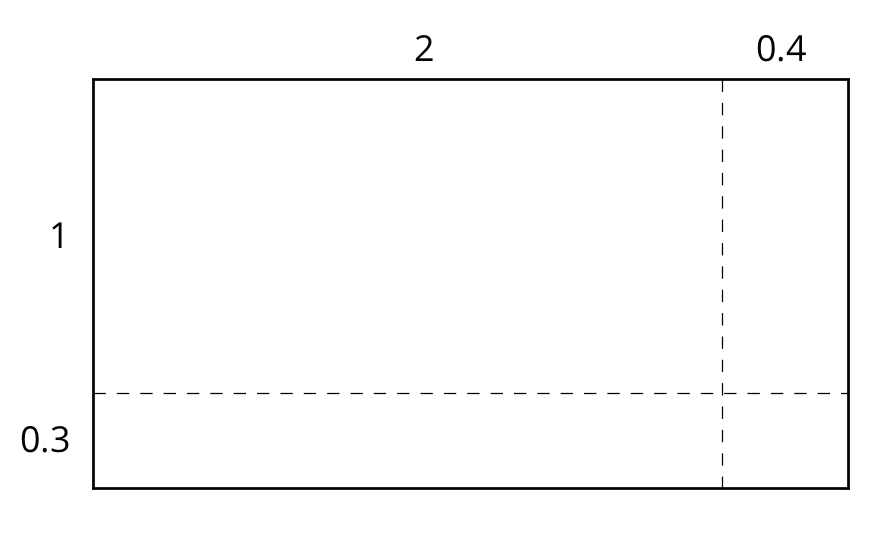
-
Find the region that represents \((0.4) \boldcdot (0.3)\)? Label that region with its area of 0.12.
-
Label each of the other regions with their respective areas.
-
Find the value of \((2.4) \boldcdot (1.3)\). Show your reasoning.
-
-
Here are two ways of calculating 2.4 times 1.3.
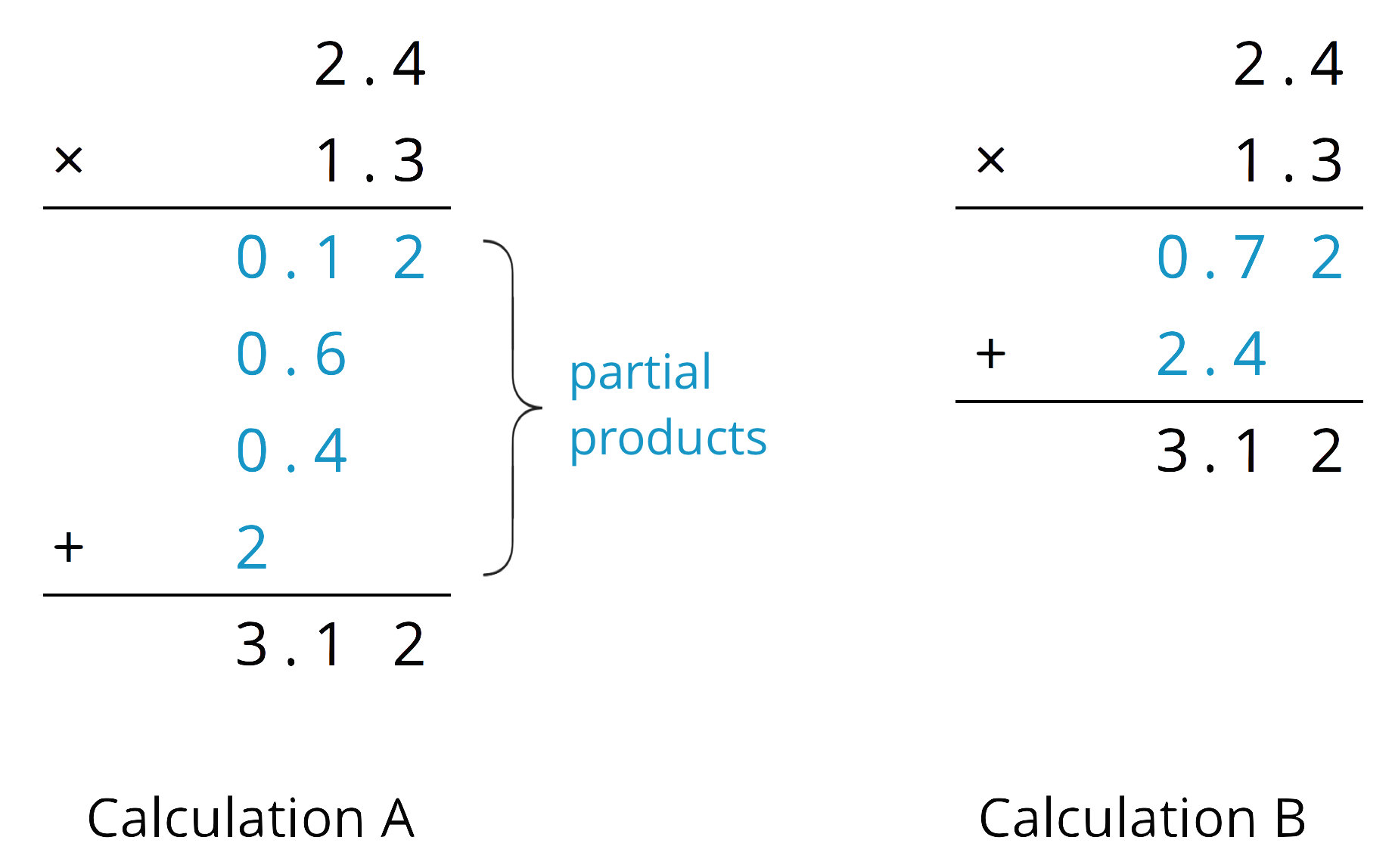
Analyze the calculations and discuss with a partner:
- In Calculation A, where does the 0.12 and other partial products come from? In Calculation B, where do the 0.72 and 2.4 come from? How are the other numbers in blue calculated?
- In each calculation, why are the numbers in blue lined up vertically the way they are?
-
Find the product of \((3.1) \boldcdot (1.5)\) by drawing and labeling an area diagram. Show your reasoning.
-
Show how to calculate \((3.1) \boldcdot (1.5)\) using numbers without a diagram. Be prepared to explain your reasoning. If you are stuck, use the examples in a previous question to help you.
-
Use the applet to verify your answers and explore your own scenarios. To adjust the values, move the dots on the ends of the segments.
Student Response
For access, consult one of our IM Certified Partners.
Launch
Arrange students in groups of 2. Give students 1–2 minutes of quiet think time for the first problem. Pause for a brief whole-class discussion, making sure all students label each region correctly. Explain that the diagram is not to scale, and that when drawing an area diagram, it is fine to estimate appropriate side lengths.
Have partners analyze the calculations in the second question. Monitor student discussions to check for understanding. If necessary, pause to have a whole-class discussion on the interpretation of these calculations. Then give students 7–8 minutes of quiet time to complete the remaining questions. Follow up with a whole-class discussion to emphasize how partial area products relate to the calculations.
Students with access to the digital materials can also work in groups of 2. When using the applet, students adjust the values by moving the dots on the ends of the segments to match the calculation. After giving students 3–4 minutes to log-in and complete the first problem, pause to discuss, making sure all students label each region correctly. Then they should also use the applet to check their calculations. Explain that diagrams may not be to scale, and that when drawing an area diagram, it is fine to estimate appropriate side lengths.
Supports accessibility for: Visual-spatial processing
Student Facing
-
You can use area diagrams to represent products of decimals. Here is an area diagram that represents \((2.4) \boldcdot (1.3)\).

- Find the region that represents \((0.4) \boldcdot (0.3)\). Label it with its area of 0.12.
- Label the other regions with their areas.
- Find the value of \((2.4) \boldcdot (1.3)\). Show your reasoning.
-
Here are two ways of calculating \((2.4) \boldcdot (1.3)\).

Analyze the calculations and discuss these questions with a partner:
-
In Calculation A, where does the 0.12 and other partial products come from?
-
In Calculation B, where do the 0.72 and 2.4 come from?
-
In each calculation, why are the numbers below the horizontal line aligned vertically the way they are?
-
-
Find the product of \((3.1) \boldcdot (1.5)\) by drawing and labeling an area diagram. Show your reasoning.
-
Show how to calculate \((3.1) \boldcdot (1.5)\) using numbers without a diagram. Be prepared to explain your reasoning. If you are stuck, use the examples in a previous question to help you.
Student Response
For access, consult one of our IM Certified Partners.
Student Facing
Are you ready for more?
How many hectares is the property of your school? How many morgens is that?
Student Response
For access, consult one of our IM Certified Partners.
Activity Synthesis
To highlight the role of place value in multiplication, discuss the following questions:
- How does the diagram for the product \((2.4) \boldcdot (1.3)\) compare to that for \(24 \boldcdot 13\)? (They are the same; the only difference is that the decimal side lengths—the factors—are one-tenth of the whole-number ones.
- How are the two calculations similar? How are they different? (There are no decimals in the partial products of \(24 \boldcdot 13\). There are 0’s at the end of the numbers in the calculation for \(24 \boldcdot 13\) but not in the other calculation. The non-zero numbers are the same in the two calculations.)

Prompt students to look at the close relationship between the partial-product calculations and the technique of using fractions to find products of decimals. Students previously saw that \((2.4) \boldcdot (1.3) = (24 \boldcdot \frac{1}{10}) \boldcdot (13 \boldcdot \frac{1}{10}) = (24 \boldcdot 13) \boldcdot (\frac {1}{10} \boldcdot \frac {1}{10})= 312 \boldcdot \frac{1}{100} = 3.12\).
The two partial-product calculations, presented side-by-side, validate the previous reasoning. The calculation on the right shows the whole-number product of 24 and 13. The one on the left shows that when each decimal factor is one-tenth of the whole-number factor, the decimal product is one hundredth of the whole-number product, so the decimal point moves two places to the left.
Design Principle(s): Support sense-making; Maximize meta-awareness
7.4: Using the Partial Products Method (10 minutes)
Optional activity
This activity continues using partial products and area diagrams to compute products of decimals and connect area diagrams with vertical calculations. In these problems, the side lengths and areas of the rectangle are left blank. Students fill in these fields by decomposing the factors by place value and multiplying them. Like many of the activities in this unit, the work involves understanding the structure of the base-ten system used in multiplication calculations (MP7) and making sense of it from arithmetic and geometric perspectives.
Students also make another key connection about several previously developed ideas here. They see that we can write the non-zero digits of decimal factors as whole numbers, use vertical calculations to multiply them, and then attend to the decimal point in the product afterwards. In other words, they notice the algorithm for multiplication can streamline the reasoning processes they have used up to this point.
Launch
Arrange students in groups of 2. Give groups 1–2 minutes to make sense of the first set of questions and area diagram. Listen to their discussions to make sure they understand how to label the appropriate side lengths. If needed, pause the class and have a student or a group that correctly decomposed the side lengths by place value share their reasoning.
Give students 5 minutes of quiet work time for the rest of the task. Follow with a whole-class discussion.
Student Facing
-
Label the area diagram to represent \((2.5) \boldcdot (1.2)\) and to find that product.
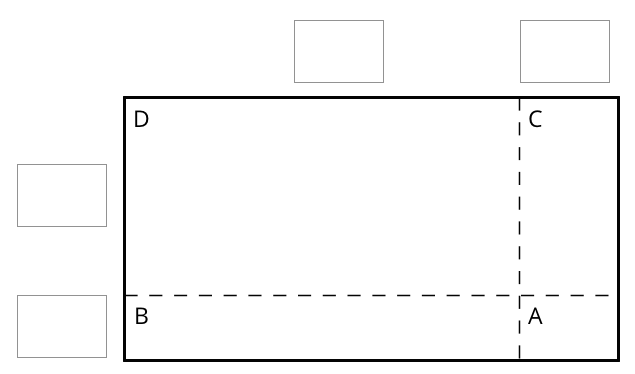
- Decompose each number into its base-ten units (ones, tenths, etc.) and write them in the boxes on each side of the rectangle.
- Label Regions A, B, C, and D with their areas. Show your reasoning.
- Find the product that the area diagram represents. Show your reasoning.
-
Here are two ways to calculate \((2.5) \boldcdot (1.2)\). Each number with a box gives the area of one or more regions in the area diagram.
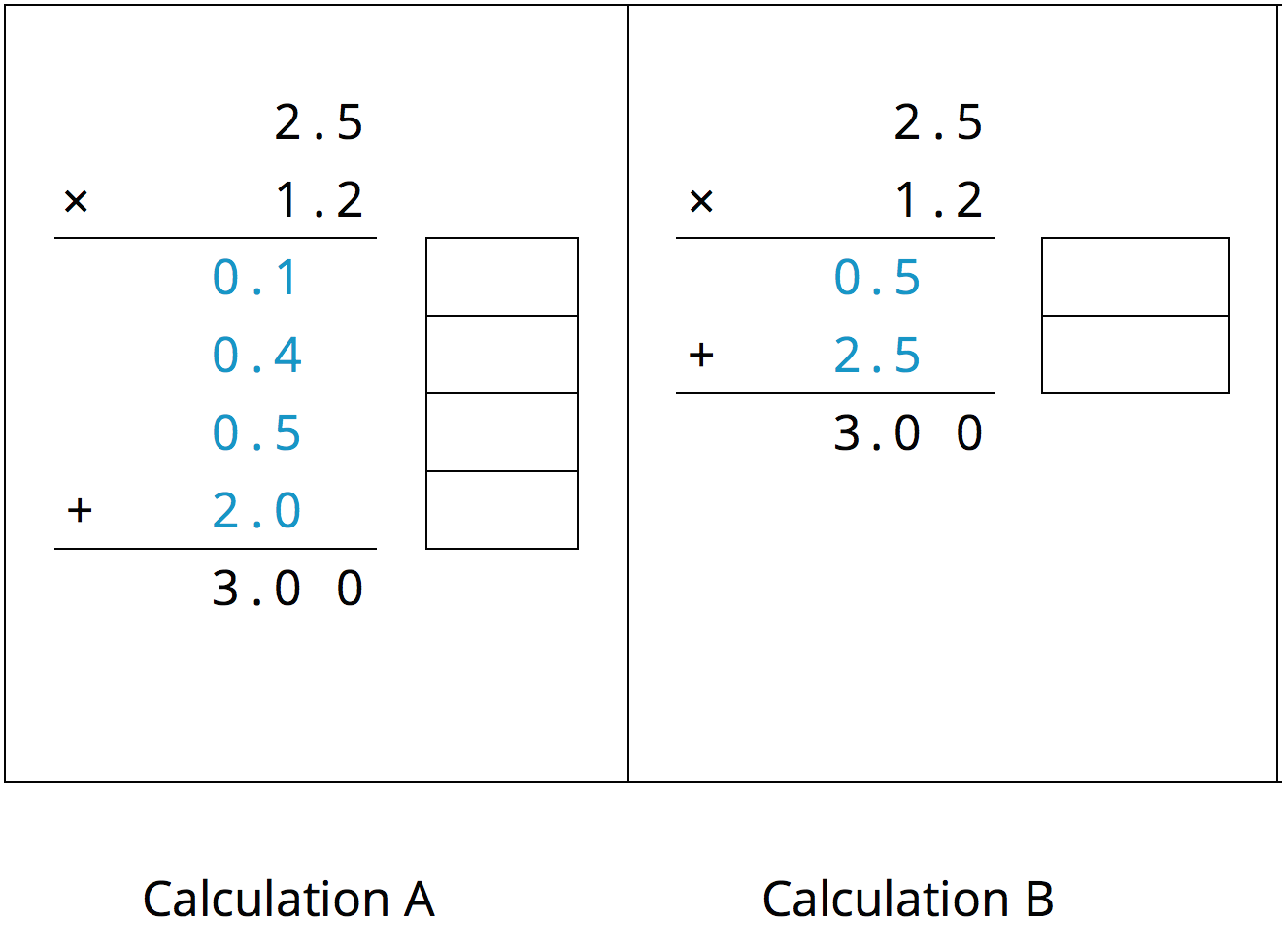
-
In the boxes next to each number, write the letter(s) of the corresponding region(s).
-
In Calculation B, which two numbers are being multiplied to obtain 0.5?
Which numbers are being multiplied to obtain 2.5?
-
Student Response
For access, consult one of our IM Certified Partners.
Anticipated Misconceptions
If students label side lengths with numbers that are not single-digit multiples of powers of ten, remind them to work with base-ten units as practiced in the previous lesson. Provide them with one label for a length and see if they can then find the other sections.
Activity Synthesis
Display the solution shown here for all to see.
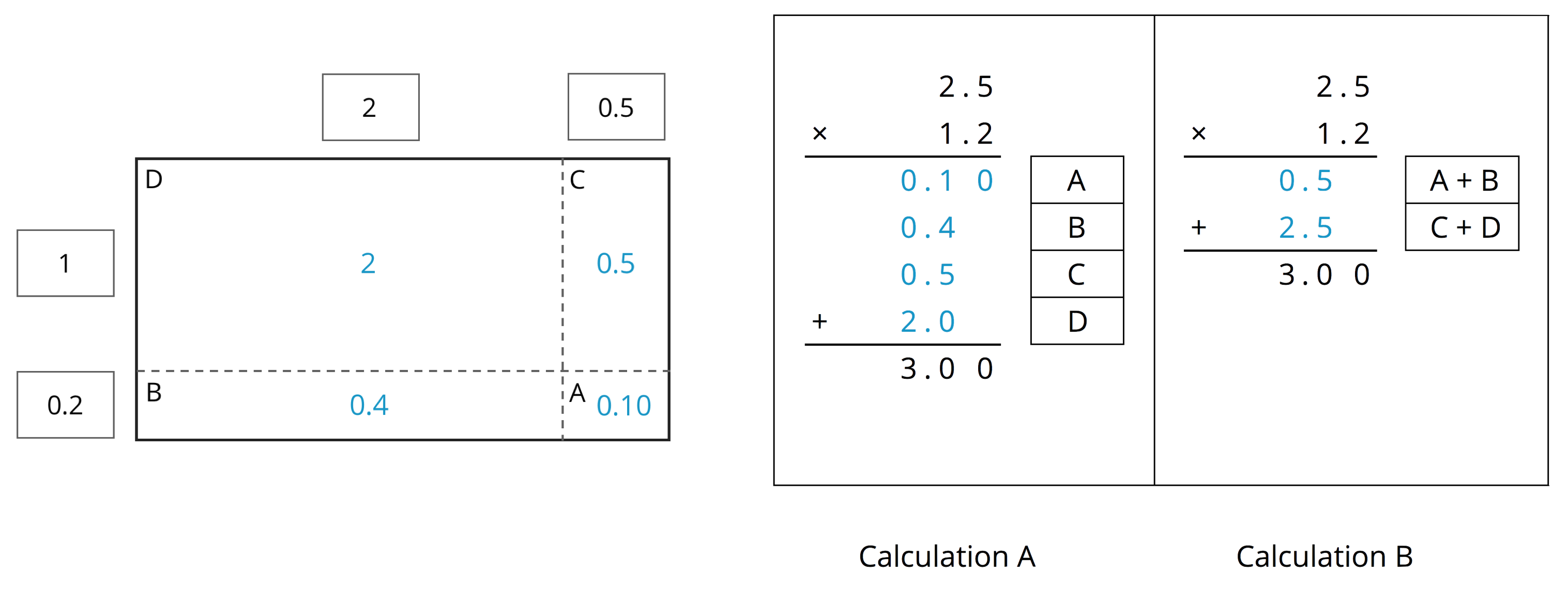
Select a few students to explain how they determined which factor belongs to which side of the rectangle and how they found each partial area. Then, ask how each blue number in the calculations, especially Calculation B, is obtained. If not mentioned in students' explanations, emphasize that the blue 0.5, represented by the area of A + B in the diagram, is the product of 0.2 and 2.5. To highlight this connection, consider shading or coloring the corresponding areas in the diagram and circling these values in the calculations. Likewise, the blue 2.5, represented by the area of C + D in the diagram, is the product of 1 and 2.5 in the calculation.
Lesson Synthesis
Lesson Synthesis
We can use the area of a rectangle to represent products of decimals, just as we have done so with whole numbers. The calculations of partial products and their sum can also be performed numerically and without a diagram. The numbers in a vertical calculation correspond closely to the partial areas in the diagram.
- How can a rectangle help us represent the product of two numbers? (The sides of a rectangle can represent the factors, and the area of the rectangle represents the product.)
- How do we use a rectangle to help us find the product of two numbers? (We can decompose each factor by place value—tens, ones, tenths, hundredths, etc., partition the rectangle into regions, and find the areas of these regions. The sum of these partial areas is the product of the two numbers. This method can be used with whole numbers and decimals.)
- How are the numbers in vertical calculations related to those in area diagrams? (The numbers in vertical calculations reflect the partial areas in diagram. These partial areas are added to find the product of the two factors.)
7.5: Cool-down - Find the Product (5 minutes)
Cool-Down
For access, consult one of our IM Certified Partners.
Student Lesson Summary
Student Facing
Suppose that we want to calculate the product of two numbers that are written in base ten. To explain how, we can use what we know about base-ten numbers and areas of rectangles.
Here is a diagram of a rectangle with side lengths 3.4 units and 1.2 units.
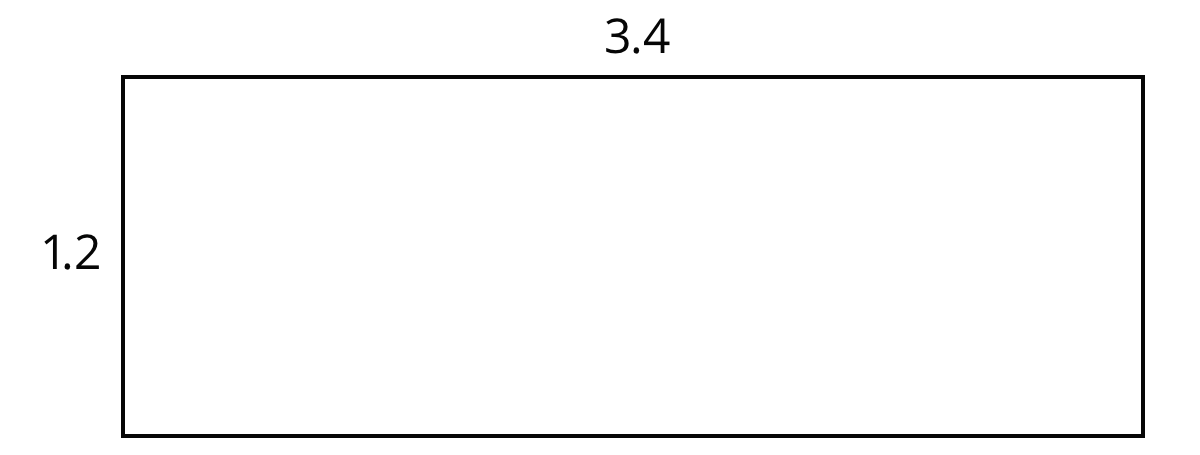
Its area, in square units, is the product
\((3.4) \boldcdot (1.2)\)
To calculate this product and find the area of the rectangle, we can decompose each side length into its base-ten units, \(3.4 = 3 + 0.4\) and \(1.2= 1 + 0.2\), decomposing the rectangle into four smaller sub-rectangles.
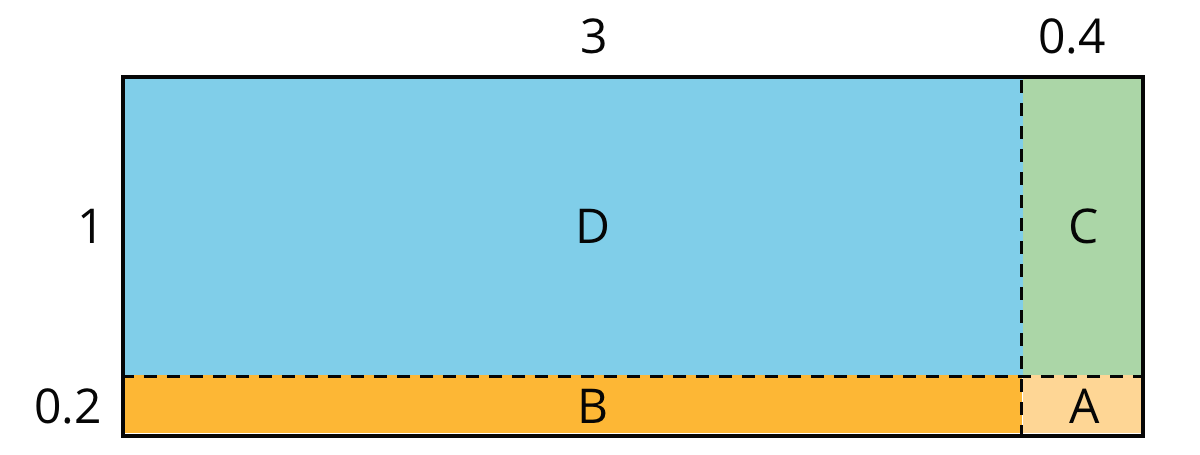
We can rewrite the product and expand it twice:
\(\begin{align} (3.4) \boldcdot (1.2) &= (3 + 0.4) \boldcdot (1 + 0.2)\\ &=(3 + 0.4) \boldcdot 1 + (3 + 0.4) \boldcdot 0.2\\ &=3 \boldcdot 1+ 3 \boldcdot (0.2)+ (0.4) \boldcdot 1 + (0.4)\boldcdot (0.2)\\ \end{align}\)
In the last expression, each of the four terms is called a partial product. Each partial product gives the area of a sub-rectangle in the diagram. The sum of the four partial products gives the area of the entire rectangle.
We can show the horizontal calculations above as two vertical calculations.
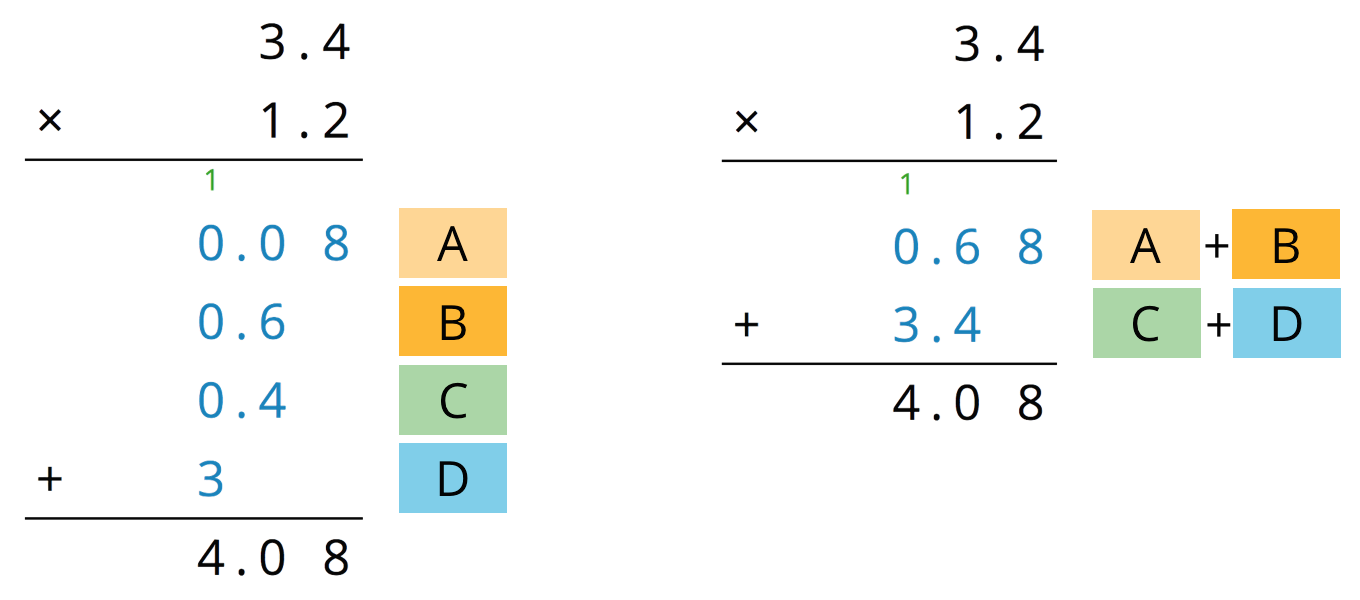
The calculation on the left is an example of the partial products method. It shows the values of each partial product and the letter of the corresponding sub-rectangle. Each partial product gives an area:
- A is 0.2 unit by 0.4 unit, so its area is 0.08 square unit.
- B is 3 units by 0.2 unit, so its area is 0.6 square unit.
- C is 0.4 unit by 1 unit, so its area is 0.4 square unit.
- D is 3 units by 1 unit, so its area is 3 square units.
- The sum of the partial products is \(0.08 + 0.6 +0.4+ 3\), so the area of the rectangle is 4.08 square units.
The calculation on the right shows the values of two products. Each value gives a combined area of two sub-rectangles:
- The combined regions of A and B have an area of 0.68 square units; 0.68 is the value of \((3 + 0.4) \boldcdot 0.2\).
- The combined regions of C and D have an area of 3.4 square units; 3.4 is the value of \((3 + 0.4) \boldcdot 1\).
- The sum of the values of two products is \(0.68 + 3.4\), so the area of the rectangle is 4.08 square units.